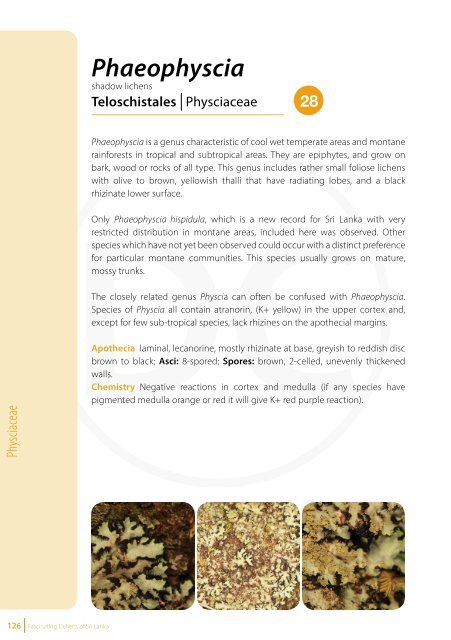You also want an ePaper? Increase the reach of your titles
YUMPU automatically turns print PDFs into web optimized ePapers that Google loves.
Phaeophyscia<br />
shadow lichens<br />
Teloschistales Physciaceae<br />
28<br />
Phaeophyscia is a genus characteristic <strong>of</strong> cool wet temperate areas and montane<br />
rainforests in tropical and subtropical areas. They are epiphytes, and grow on<br />
bark, wood or rocks <strong>of</strong> all type. This genus includes rather small foliose lichens<br />
with olive to brown, yellowish thalli that have radiating lobes, and a black<br />
rhizinate lower surface.<br />
Only Phaeophyscia hispidula, which is a new record for <strong>Sri</strong> <strong>Lanka</strong> with very<br />
restricted distribution in montane areas, included here was observed. Other<br />
species which have not yet been observed could occur with a distinct preference<br />
for particular montane communities. This species usually grows on mature,<br />
mossy trunks.<br />
The closely related genus Physcia can <strong>of</strong>ten be confused with Phaeophyscia.<br />
Species <strong>of</strong> Physcia all contain atranorin, (K+ yellow) in the upper cortex and,<br />
except for few sub-tropical species, lack rhizines on the apothecial margins.<br />
Physciaceae<br />
Apothecia laminal, lecanorine, mostly rhizinate at base, greyish to reddish disc<br />
brown to black; Asci: 8-spored; Spores: brown, 2-celled, unevenly thickened<br />
walls.<br />
Chemistry Negative reactions in cortex and medulla (if any species have<br />
pigmented medulla orange or red it will give K+ red purple reaction).<br />
Phaeophyscia hispidula Whiskered shadow lichens<br />
SL<br />
Description Fruticose. The thallus is corticolous, and pale greyish brown or<br />
yellow brown with, relatively broad lobes, rather concave tips, and a white<br />
medulla. Soredia are present mainly on the margins and lobe surface. The lower<br />
surface is black. Black rhizines are abundant and long, projecting beyond the<br />
lobes, and <strong>of</strong>ten coalesce in to a mat, and appear as a fringe <strong>of</strong> “whiskers” when<br />
viewed from above. Apothecia are not observed on the <strong>Sri</strong> <strong>Lanka</strong>n material.<br />
R<br />
Fr<br />
Physciaceae<br />
Status This rare species can be easily found as it forms a large colony on the<br />
mature trunks <strong>of</strong> trees in shaded interiors. New record for <strong>Sri</strong> <strong>Lanka</strong>.<br />
Habitat Mostly restricted to humid high elevation forests above 1200 m.<br />
Locations Horton Plains and Hakgala strict nature reserve.<br />
126 <strong>Fascinating</strong> <strong>Lichens</strong> <strong>of</strong> <strong>Sri</strong> <strong>Lanka</strong><br />
<strong>Fascinating</strong> <strong>Lichens</strong> <strong>of</strong> <strong>Sri</strong> <strong>Lanka</strong> 127















